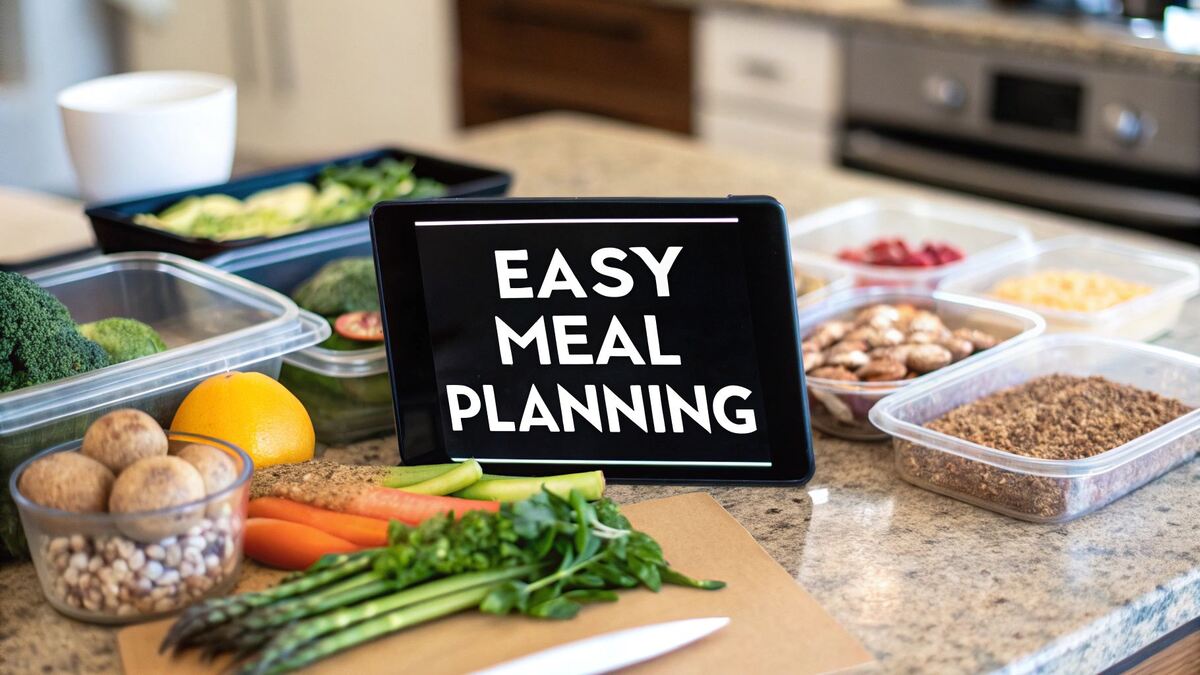Easy Healthy Meal Planning That Actually Works
Meal planning is really just a way to cut down on stress by figuring out what you’re going to eat ahead of time. The secret isn't to create some hyper-organized, rigid schedule that you'll abandon in a week. It’s about building a flexible routine around the meals you already like to eat.
Why Meal Planning Feels So Overwhelming
Let's get real for a second: the thought of meal planning can feel like just another draining chore piled on top of an already massive to-do list. You've had a long day, and the absolute last thing your brain wants to do is make one more decision. That nagging question, "What's for dinner?" can quickly become a major source of daily stress.
If this sounds familiar, you're not alone. It's not a personal failing; it's a completely normal struggle. For so many of us, the mental energy it takes to organize a full week of meals, figure out snacks, and write a grocery list is just too much. Often, this feeling of being totally swamped is tied to challenges with our executive function skills—the very brain processes we need to get organized and start a task like this.
The Cycle of Dread and Defeat
It usually kicks off on a Sunday night. You sit down, full of good intentions, but staring at that blank weekly calendar is just intimidating. You start scrolling through recipes online, and suddenly the pressure to plan a week of perfectly balanced, beautiful meals feels paralyzing. It’s like you need to be a professional chef with a ton of free time just to pull it off.
This pressure is what creates that vicious cycle: you try to plan, get completely overwhelmed, and then just give up. Next thing you know, it’s Wednesday, the plan is long gone, and you’re ordering takeout again. The issue here isn't a lack of motivation—it's the flawed idea that meal planning has to be complicated and perfect from the start.
This whole process flow really highlights the three main psychological roadblocks people run into.
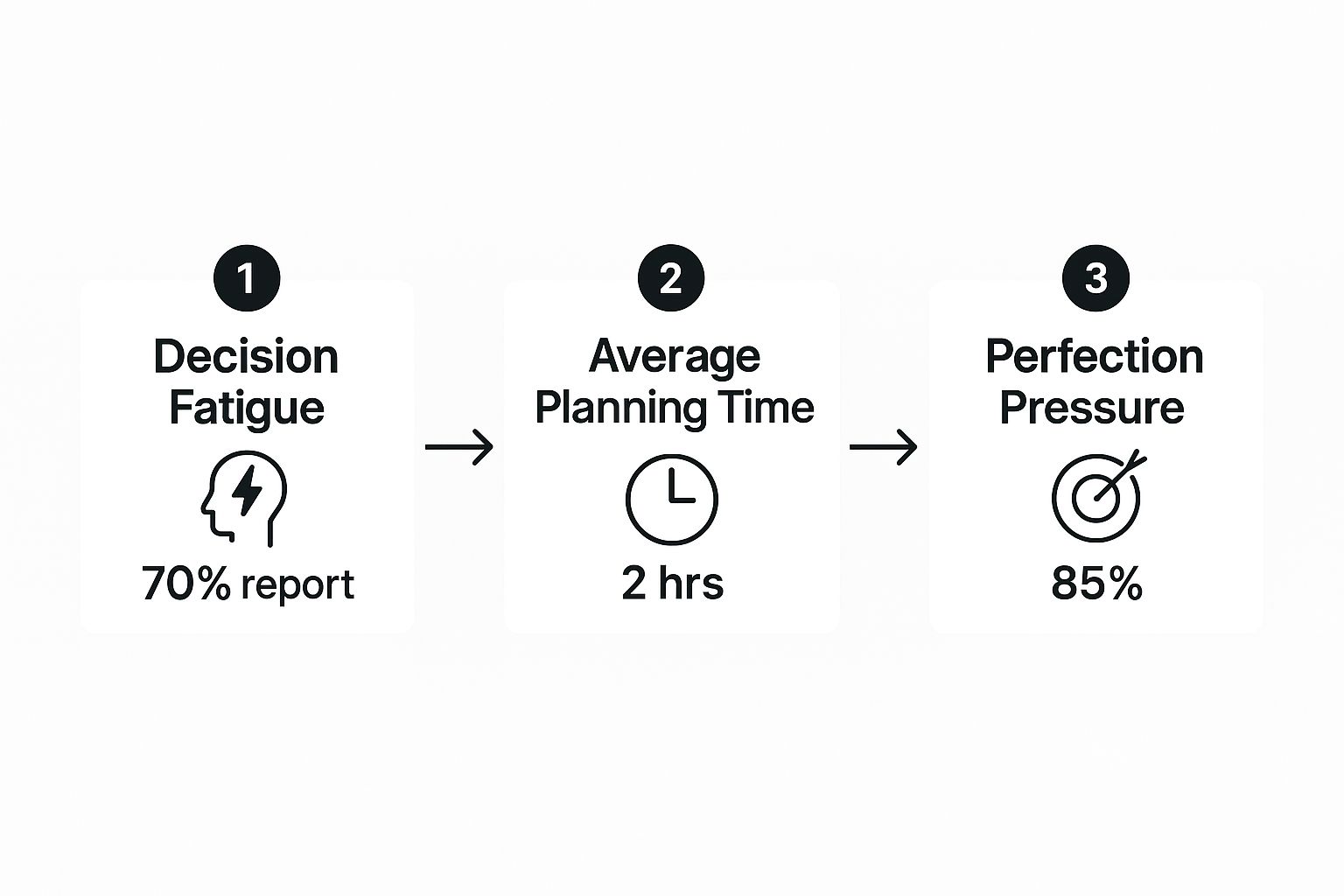
As you can see, the combination of decision fatigue, the time you think it'll take, and the pressure for perfection is what makes it so hard for people to even get started.
Redefining Easy Healthy Meal Planning
It’s time to throw out the myth that meal planning requires a complete lifestyle overhaul. Real, easy healthy meal planning isn't about color-coded spreadsheets or trying a fancy new recipe every single night. It’s about building a simple, repeatable system that actually fits into your life.
The goal is to reduce stress, not create more of it. A good meal plan is a tool that gives you freedom—it frees up your mental space, saves you money, and puts you back in control of your health.
Think about it this way: you aren't chaining yourself to a restrictive diet. You're simply creating a flexible framework that helps you make thoughtful choices about food. This approach is all about:
- Using Your Go-To Meals: Leaning on a core group of simple, healthy recipes you already know how to make and enjoy.
- Building in Flexibility: Planning for leftovers, a spontaneous pizza night, or last-minute changes without feeling guilty about it.
- Keeping It Simple: Choosing meals that are quick to throw together instead of complex cooking projects.
When you shift your focus from perfection to practicality, meal planning stops being a dreaded chore and starts becoming an empowering habit. It sets you up for long-term success with your health and brings a little less chaos to your daily life.
How To Build Your Personal Meal Planning System
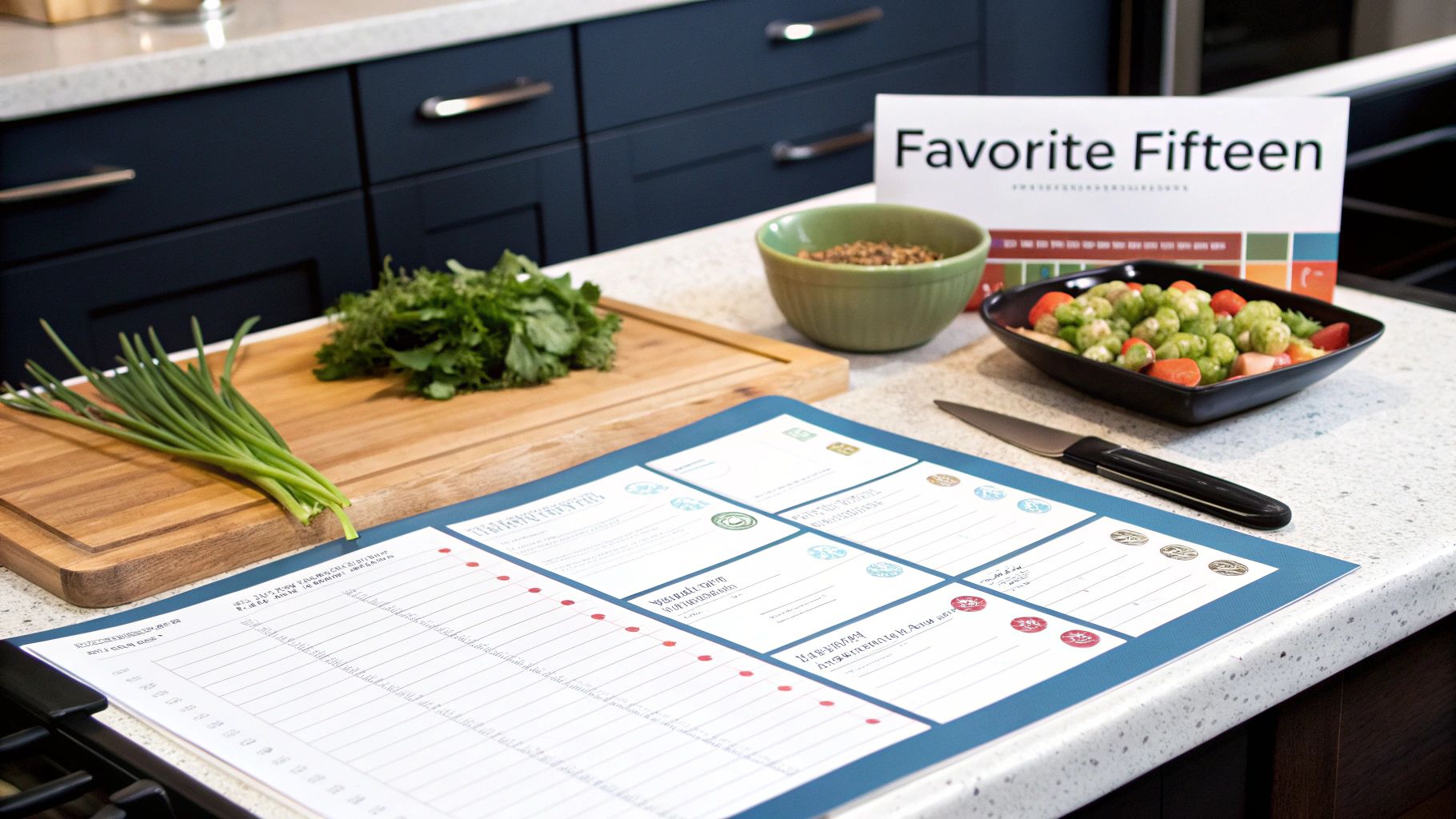
Let's be honest: most generic meal plans you find online are doomed to fail. They're rigid, don't account for real life, and often feel like a chore by Tuesday. The secret to a system that actually sticks is to build one that bends and flows with your life.
Before you even think about recipes, the first step is a quick, honest self-audit. This isn't about judging your habits; it’s about gathering intel to build a plan you can sustain. If you want to know how to plan weekly meals without stress, this is where you start.
Ask yourself a few simple but game-changing questions:
- How many meals do I realistically need to plan? If you have a team lunch every Wednesday and date night on Fridays, you can immediately cross those off your list. Be real about your social life and routines.
- What’s my main goal right now? Are you trying to sneak in more veggies, boost your protein intake, or just rely less on takeout? Your "why" will guide every choice you make.
- How much time am I actually willing to spend cooking? If you know 30-minute meals are your sweet spot, don’t set yourself up for failure with complex recipes that take an hour.
This personal inventory is your foundation. It ensures the plan you build is for you, not some imaginary, super-organized version of yourself.
Introducing Your “Favorite Fifteen”
One of the biggest mistakes I see people make with easy healthy meal planning is trying to reinvent the wheel every single week. You don't need a constant flood of new recipes to eat well. In fact, the opposite is often true.
This is where the "Favorite Fifteen" concept comes in. It’s a game-changer. Just make a list of 10 to 15 go-to healthy meals that you already know how to cook and genuinely enjoy eating. This becomes your personal, curated recipe book.
Your list might look something like this:
- Sheet-pan chicken with roasted broccoli and sweet potatoes
- A big batch of hearty lentil soup
- Quick turkey tacos with black beans and avocado
- Salmon with a side of fast-cooking quinoa and asparagus
Think of these as your anchors. When you’re feeling uninspired or slammed with work, you just pull from this list. It completely eliminates decision fatigue and guarantees you’ll have food you actually want to eat. For a little inspiration on what makes a complete meal, our guide to a balanced meal plan is a fantastic resource.
Mapping Out A Realistic Weekly Schedule
Okay, you've done your self-audit and have your Favorite Fifteen list ready. Now it's time to sketch out your week. The key here is sustainability, which means building in breaks and shortcuts so you don't burn out.
A meal plan isn't a rigid contract; it's a flexible guide designed to make your life easier. The best plans have built-in breathing room for leftovers, lazy nights, and life's little surprises.
Instead of trying to cook from scratch every night, get strategic. A smart weekly structure might look something like this:
- Monday (Cook Night): Cook a bigger batch of whatever you’re making. For instance, if it’s chicken stir-fry, cook double the chicken.
- Tuesday (Leftover Night): The best kind of night—no cooking required! Enjoy what you made on Monday.
- Wednesday (Assembly-Only Night): Use that extra chicken from Monday to throw together quick chicken salads or wraps. Zero cooking, just assembling.
- Thursday (Cook Night): Time to make another meal from your Favorite Fifteen list.
- Friday (Flexible Night): This is your free space. Plan for leftovers, grab takeout, or go out for dinner.
This isn't just a food plan; it's an energy management plan. It acknowledges the reality that your motivation to cook will ebb and flow. By building in these effortless nights, you create a system that you're so much more likely to stick with for the long haul.
Your Flexible Weekly Meal Planning Template
Here’s a simple template to help you map things out. The goal isn't to fill every single box, but to create a rough guide that takes the daily guesswork out of eating.
| Day | Breakfast | Lunch | Dinner | Notes (e.g., Leftovers, Cook Night) |
|---|---|---|---|---|
| Monday | Oatmeal | Leftover... | Chicken Stir-fry | Cook Night (make extra chicken) |
| Tuesday | Yogurt | Leftover... | Leftover Stir-fry | Leftover Night |
| Wednesday | Oatmeal | Salad | Chicken Salad Wraps | Assembly Night (use extra chicken) |
| Thursday | Yogurt | Leftover... | Lentil Soup | Cook Night (make a big batch) |
| Friday | Oatmeal | Leftover... | Takeout / Dinner Out | Flexible Night |
| Saturday | Pancakes | Leftover... | Tacos | |
| Sunday | Yogurt | Leftover... | Leftover Lentil Soup | Prep for the week ahead |
Remember to plug in your "Favorite Fifteen" meals and identify your cook nights and leftover nights ahead of time. This simple act of planning frees up so much mental space during the week.
Making Smart Food Choices Without Complicated Rules
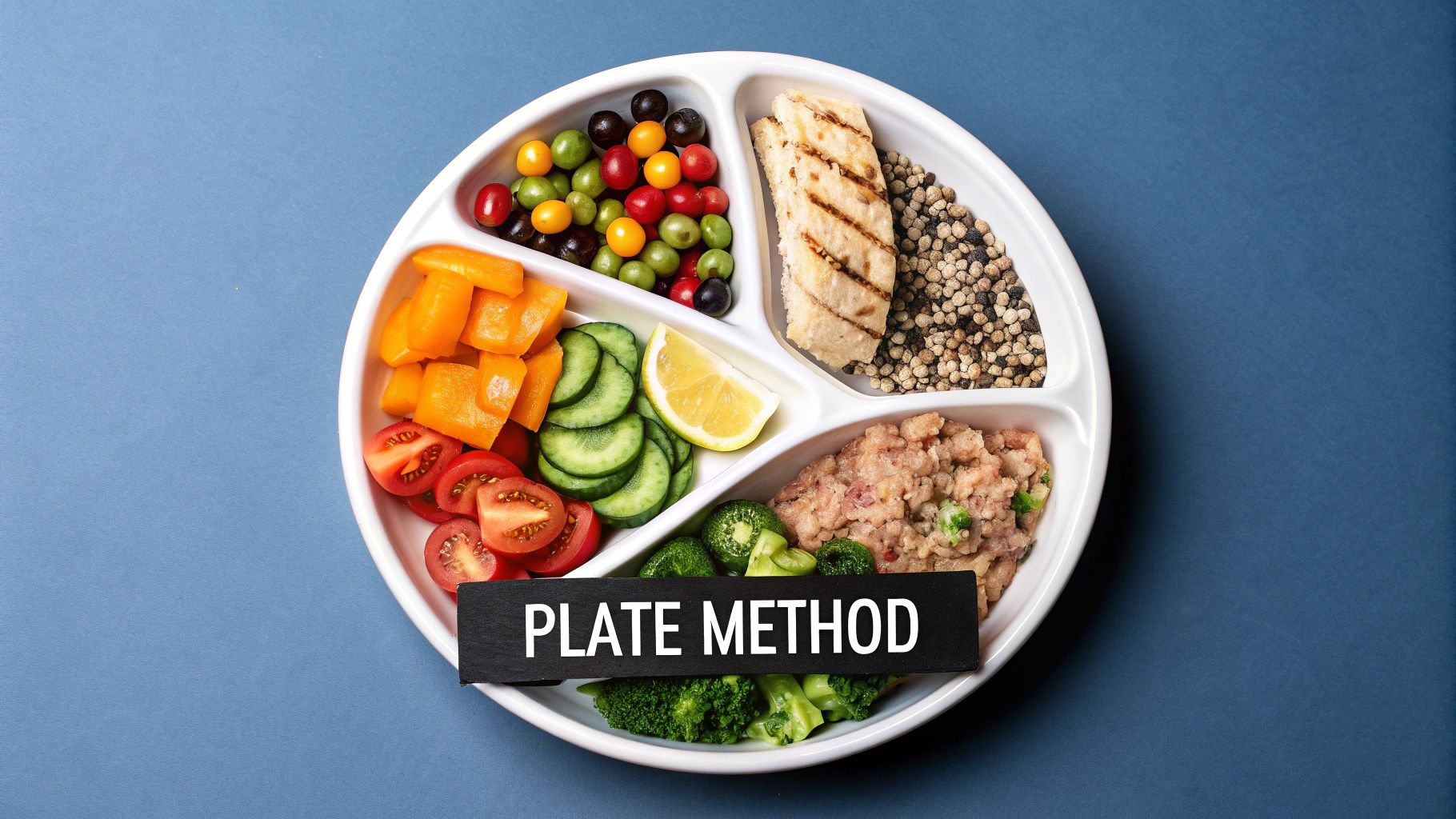
Let's be honest: healthy eating can feel overwhelming. We're bombarded with messages about counting calories, tracking macros, and following strict rules. But what if I told you that making smart food choices doesn't require a nutrition degree or a calculator at every meal?
The real secret is to make good nutrition feel intuitive, not intimidating. That’s where visual guides come in. Instead of getting bogged down in numbers, you can use a simple, proven framework to build balanced meals, every single time. This is a cornerstone of truly easy healthy meal planning.
The Simple Power Of The Plate Method
Think of your dinner plate as a blank canvas. The Plate Method is your cheat sheet for painting a nutritionally balanced picture, no complex math required. It’s a visual trick that works wonders for ensuring you get the right mix of foods without the headache.
Here's the breakdown:
- Fill Half Your Plate with Non-Starchy Vegetables: This is your foundation. We're talking vibrant, colorful veggies like leafy greens, broccoli, bell peppers, asparagus, and zucchini. They’re packed with fiber and nutrients but low in calories, helping you feel full and satisfied.
- Fill One Quarter with Lean Protein: This section is for your powerhouse proteins that build muscle and keep hunger at bay. Think grilled chicken breast, baked fish, lean turkey, tofu, lentils, or beans.
- Fill the Final Quarter with Complex Carbohydrates: This is your primary energy source. Focus on whole, unprocessed carbs for sustained energy—things like quinoa, brown rice, sweet potatoes, or a slice of whole-grain bread.
By following this simple 50-25-25 split, you're automatically building a balanced meal that keeps portions in check and supports your health goals. It takes the mental strain out of the equation.
The real beauty of the Plate Method is its simplicity. It’s not a diet; it’s a sustainable guideline that empowers you to build a healthy meal anywhere—at home, at a restaurant, or at a family gathering.
Putting The Plate Method Into Practice
Once you start thinking in these food groups, grocery shopping and meal prep become so much easier. Instead of getting stuck on what to make, you just ask, "What's my protein, what's my carb, and what are my veggies?"
Here are some quick ideas to get you started:
- Protein Power: Make sure every main meal has a solid protein source. Swap processed meats for baked salmon, grilled chicken strips, or a hearty lentil stew.
- Carb Swaps: Trade simple carbs for complex ones. Think quinoa instead of white rice, or a bowl of oatmeal instead of sugary cereals.
- Veggie Boost: Don’t be shy! Add a large handful of spinach to your morning smoothie, snack on bell pepper strips with hummus, or start every dinner with a simple side salad.
This approach makes everything from your shopping list to your weekly plan feel completely straightforward. You just pick a few items from each category and mix and match.
A Real-World Example: The Mediterranean Diet
To see how these principles play out in the real world, look no further than the Mediterranean diet. It’s a perfect illustration of an easy, healthy eating pattern that naturally aligns with the Plate Method.
Rooted in the food traditions of places like Southern Italy, this approach is all about plant-based foods, healthy fats, and lean proteins. It isn't a restrictive "diet" but a lifestyle that has been consistently linked to incredible health benefits, from a reduced risk of heart disease to improved cognitive function. Its focus on delicious, whole foods is a big reason why people can actually stick with it long-term.
A typical Mediterranean plate just is the Plate Method:
- Half Plate of Veggies: A large Greek salad with tomatoes, cucumbers, and olives.
- Quarter Plate of Protein: A piece of grilled fish, like salmon or cod.
- Quarter Plate of Carbs: A serving of whole-grain couscous.
This way of eating is celebrated not just for being healthy, but for being incredibly flavorful and satisfying. If you're curious, check out our guide on getting started with a Mediterranean meal plan. It’s a great example of how balanced eating can be about abundance and enjoyment, not restriction.
How to Shop and Prep for a Stress-Free Week
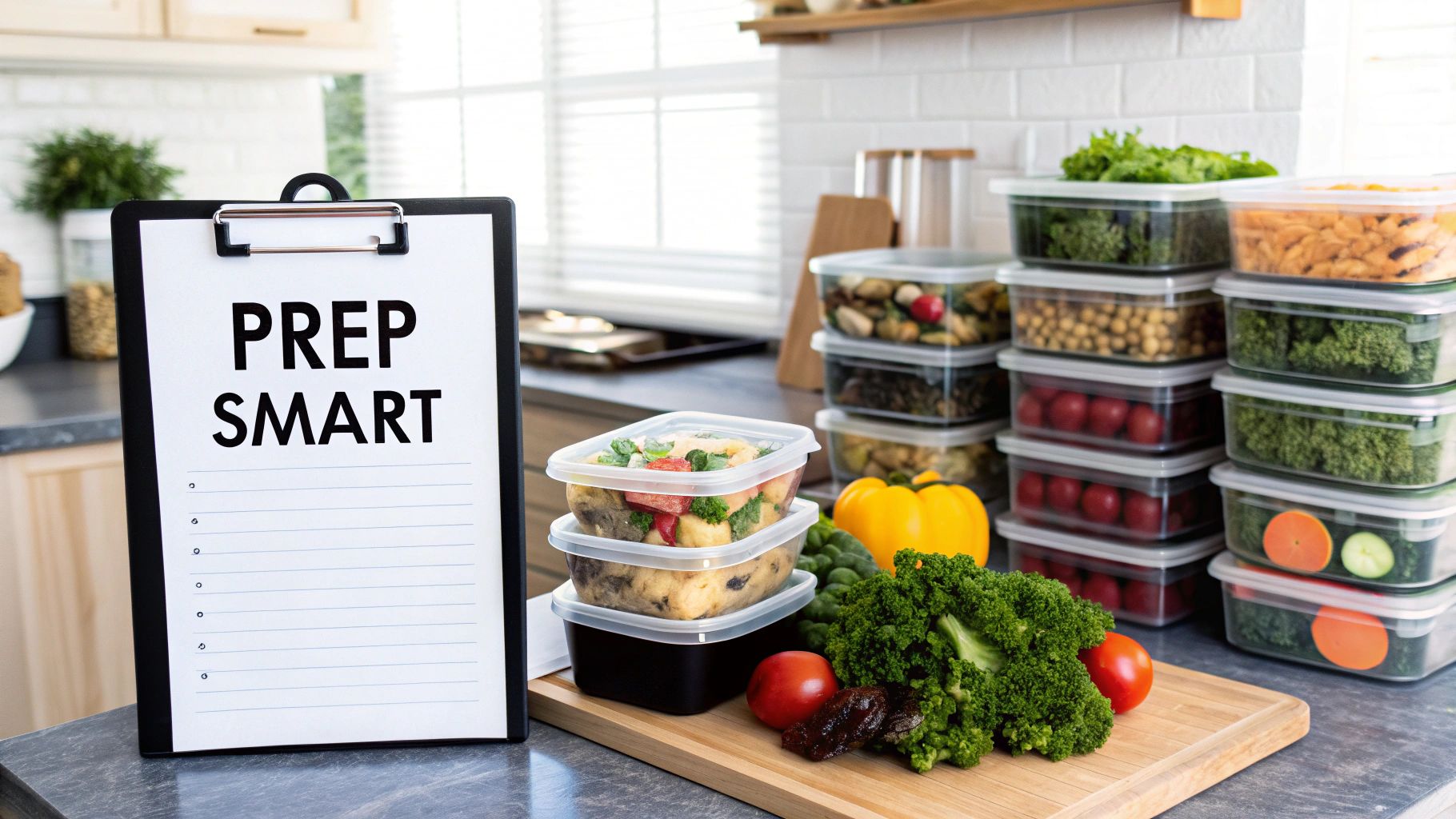
A perfectly designed meal plan is fantastic, but it's really just a piece of paper until you bring it to life in your kitchen. This is where the real magic of easy healthy meal planning happens—turning those ideas into delicious, ready-to-eat meals that rescue you from the "what's for dinner?" panic all week long.
The bridge between your plan and your plate is smart shopping and a little bit of prep. This isn't about spending your entire Sunday chained to the stove. It's about a small, upfront investment of time that pays off big time when you're tired and hungry on a Tuesday night.
Build a Smarter Shopping List
Think of your grocery list as your game plan for an efficient shopping trip. A random list of ingredients scribbled on a notepad is a surefire way to wander aimlessly down every aisle, which almost always leads to impulse buys that can derail your health goals and your budget.
Instead, create a hyper-organized list categorized by the store's layout. This simple tweak gets you in and out faster and keeps you laser-focused.
- Produce: Group all your fruits and veggies here. Think bell peppers, onions, spinach, apples, and bananas.
- Proteins: This is for everything from the meat and seafood counter or the plant-based section, like chicken breasts, salmon fillets, tofu, and eggs.
- Pantry & Dry Goods: List all your shelf-stable items—quinoa, brown rice, canned beans, olive oil, and spices.
- Dairy & Refrigerated: Yogurt, milk, cheese, and anything else that needs to stay cold belongs in this category.
This method creates a logical path through the store, minimizing backtracking and the temptation to grab that bag of chips from the snack aisle.
Find Your Meal Prep Style
The term "meal prep" can sound intense, conjuring images of endless rows of identical plastic containers. It really doesn't have to be an all-or-nothing effort. The key is finding a level of prep that actually fits your schedule and energy.
You can think of it in three main tiers, and you can absolutely mix and match them depending on what your week looks like.
The Three Tiers of Meal Prep
| Prep Style | Description | Best For |
|---|---|---|
| Prep Lite | Just the absolute basics. Wash and chop your vegetables, like onions and bell peppers. Portion out snacks into bags. | People who are extremely short on time but want to make cooking slightly faster during the week. |
| Mid-Level Prep | Cook individual components. Batch-cook a large pot of quinoa, grill several chicken breasts, or mix up a jar of salad dressing. | Those who want flexibility. You have building blocks ready to assemble into different meals. |
| Full Prep | Assemble entire meals. Portion complete dishes like lentil soup or chicken stir-fry into grab-and-go containers. | The busiest individuals who want meals that require zero thought or effort during the week. |
You don't have to commit to just one style. Maybe this week you only have 30 minutes for some Prep Lite, but next Sunday you feel energized enough for Mid-Level Prep. It's all about what works for you.
A small, two-hour prep session on a Sunday can completely eliminate daily decision-making. Prepping ingredients—even just chopping onions, grilling some chicken, and mixing a vinaigrette—is a gift to your future, much less-stressed self.
I usually dedicate a couple of hours on Sunday to my own prep. I’ll chop a few onions and peppers, grill a family pack of chicken breasts, cook a big batch of brown rice, and wash all my lettuce. That simple effort means that throwing together a healthy grain bowl or a quick stir-fry takes me less than 15 minutes on a busy weeknight. It’s a game-changer. For those looking for plant-based ideas, our guide to a complete vegetarian meal plan is packed with inspiration perfect for this prep-ahead style.
Keep Your Prepped Food Fresh
All that prep work is only useful if the food stays fresh and appealing. Proper storage is crucial to make sure your hard work doesn't go to waste.
- Airtight Containers are Essential: A good set of glass or BPA-free plastic containers is a worthy investment. They keep air out, which is the enemy of freshness.
- Manage Moisture: For leafy greens, stick a paper towel in the container or bag. It will absorb excess moisture and keep them from wilting.
- Store Components Separately: To avoid a soggy mess, always keep dressings, sauces, and crunchy toppings separate from your salads until you're ready to eat.
By pairing a smart shopping strategy with a prep routine that feels manageable, you truly set yourself up for a week of easy, healthy eating without the daily stress.
Using Simple Tech to Streamline Your Meal Plan
While there’s a certain satisfaction to a pen-and-paper meal plan, leaning on a bit of tech can make the whole process genuinely effortless. Let's be honest, the small frustrations are what usually derail our best intentions.
Think about it: forgetting your list on the kitchen counter, endlessly scrolling for recipes that fit your diet, or trying to add up ingredients for five different meals. These are the exact headaches that modern tools are built to solve, turning a chore into a seamless part of your week.
Apps That Do More Than Just Store Recipes
The real game-changer with a good meal planning app isn't just saving recipes you like; it's about building an interconnected system. The best ones automatically generate a shopping list right from the meals you pick. That alone saves a ton of tedious work.
Many apps now have features that used to be wishful thinking:
- Smart Grocery Lists: Imagine a list that automatically sorts itself by grocery store aisle. It makes shopping trips so much faster.
- Barcode Scanning: Running low on olive oil? Just scan the barcode with your phone, and it’s instantly on your list. No more "I think we need..." moments.
- Recipe Discovery: You can filter recipes by almost anything—"gluten-free," "30-minute meals," or "high-protein"—taking all the guesswork out of finding something you can actually eat.
This kind of automation just removes the friction that makes us quit.
Beyond the Basics: Smart Integrations
Your tech-powered plan doesn't have to stop there. You can create a seriously efficient system by connecting your app to other services. For instance, many meal planning platforms now sync directly with online grocery delivery. A couple of clicks, and your entire shopping list is in a cart and scheduled to arrive at your door.
The whole point is to build a system where technology handles the boring logistics. This frees up your mental space to actually enjoy cooking and eating your food.
A shared digital note or a family calendar can also work wonders. Everyone can see what's for dinner, add their own requests, or even pitch in with the shopping.
The demand for these tools is exploding. In 2023, the global meal planning app market was already valued at around USD 1.2 billion, and it's expected to triple by 2032. This isn't just a fad; it's a response to a real need for tools that help us manage our diets and make healthy eating feel less like a full-time job. You can learn more about the meal planning app market trends and see just how much technology is shaping our approach to health.
This shift proves people are looking for simpler ways to stay healthy, and the right tech can be a powerful ally. By bringing a few simple tools into your routine, you create a flexible system that supports your easy healthy meal planning goals and gives you back a ton of time each week.
Got Questions About Meal Planning? Let’s Get Them Answered.
Even when you have a solid plan, life happens. Schedules get chaotic, kids suddenly decide they hate broccoli, and sometimes, you're just not in the mood. Sticking with a healthy meal plan means knowing how to navigate these real-world bumps in the road.
Let's dive into some of the most common questions I hear. These are the practical, everyday problems that can throw a wrench in your best-laid plans, but the solutions are often much simpler than you think.
"What If I Get Bored Of Eating The Same Things?"
This is probably the number one concern, and for good reason! No one wants their dinner rotation to feel like a culinary prison. The secret isn't to constantly hunt for brand-new, complicated recipes, but to build variety into your routine in a way that feels easy.
My personal rule of thumb is to try one new recipe every other week. It’s a low-pressure way to keep things fresh without feeling like you have to reinvent the wheel every Sunday. This simple habit is enough to introduce new flavors and ideas without totally disrupting the system that's already working for you.
Another fantastic strategy is to lean on theme nights. They give you a reliable framework but endless options for variety.
- Taco Tuesday: One week it's ground turkey, the next it's shredded chicken or black beans. You can switch up the salsa, toppings, or shells for a totally different vibe.
- Pasta Night: Experiment with different sauces like a creamy pesto or a simple marinara. Toss in whatever veggies you have on hand.
- Sheet-Pan Sunday: The technique stays the same, but the ingredients are always changing. Think chicken with broccoli and potatoes one week, then sausage with peppers and onions the next.
And remember, your "Favorite Fifteen" list isn't set in stone. When you find a new recipe your family absolutely loves, swap it in for an older one that's lost its spark. Even tiny tweaks—using shrimp instead of chicken in a stir-fry or trying a new seasoning on roasted veggies—can make a familiar meal feel brand new again.
"How Do I Plan For A Family With Picky Eaters?"
Planning meals for a family with strong opinions can feel less like cooking and more like negotiating a peace treaty. The goal here is to reduce dinnertime stress, not add to it. This takes a team effort and a bit of clever thinking.
First off, get them involved. I always let my family vote on two of the dinners for the upcoming week. When they feel like they have a say in the decision-making process, they're much more likely to be on board when that meal actually hits the table.
The most effective trick I've found for picky eaters is the "deconstructed" meal. Instead of serving a finished dish, you set up a build-your-own station where everyone can customize their own plate.
This approach is a lifesaver for so many meals:
- Taco/Burrito Bowls: Put out all the components separately—the rice, the protein, various veggies, cheese, and avocado. Everyone builds their perfect bowl.
- Pizza Night: Give everyone an individual crust or flatbread and let them go wild with a selection of toppings.
- Pasta Bar: Offer a couple of noodle shapes, a red sauce and a white sauce, and different toppings like meatballs, grilled veggies, and parmesan.
I also make it a rule to always have at least one "safe" food on the table—something simple I know everyone likes, such as plain rice, cucumber slices, or their favorite fruit. This takes the pressure off, encouraging them to try new things without the fear of going hungry if they don't like it.
"I Have No Time For Meal Prep. What Can I Do?"
I hear you. If the idea of spending two hours in the kitchen every Sunday makes you want to abandon ship before you even start, don't sweat it. You can absolutely make meal planning work without a huge, dedicated prep session.
The key is to shift your mindset from "meal prep" to "strategic assembly." Your meal plan should be built around meals you can throw together in minutes by relying on some smart shortcuts from the grocery store.
Think of your grocery list as the prep work. You're buying back your time.
- Breakfasts: Think zero-cook options like yogurt with berries and granola, or pre-made protein shakes you can just grab and go.
- Lunches: Pre-washed salad mixes are a game-changer. Just top them with a can of tuna or chickpeas. Pre-cooked lentil pouches are another fantastic, fast option.
- Dinners: A rotisserie chicken is your absolute best friend. It can easily become three different meals: chicken tacos on night one, chicken salad sandwiches for lunch the next day, and the rest tossed into pasta on night three.
Don't be afraid to embrace healthy convenience items. Frozen vegetables are just as nutritious as fresh, pre-chopped veggies from the produce aisle save a ton of time, and a high-quality jarred pasta sauce is a pantry staple. Your "cooking" becomes more about assembling these components than starting from scratch, making a healthy meal plan feel doable even on the most chaotic weeks.
Ready to stop stressing and start planning? The AI Meal Planner creates personalized meal plans based on your goals, tastes, and schedule, taking all the guesswork out of healthy eating. Get your custom plan today at ai-mealplan.com.
AI-powered nutrition
Get Your Personalized Meal Plan
AI creates the perfect meals for your goals, lifestyle, and taste.
Start Your Journej
